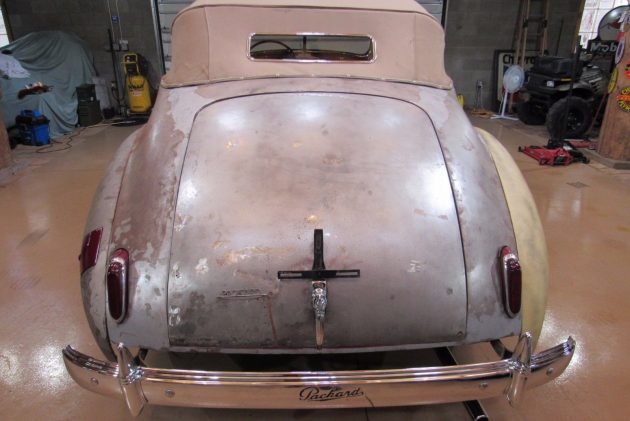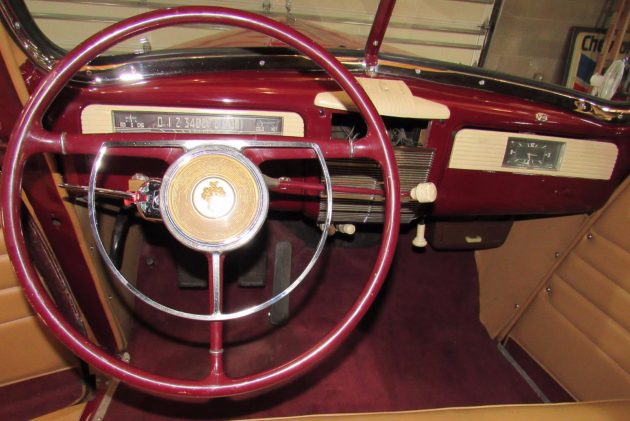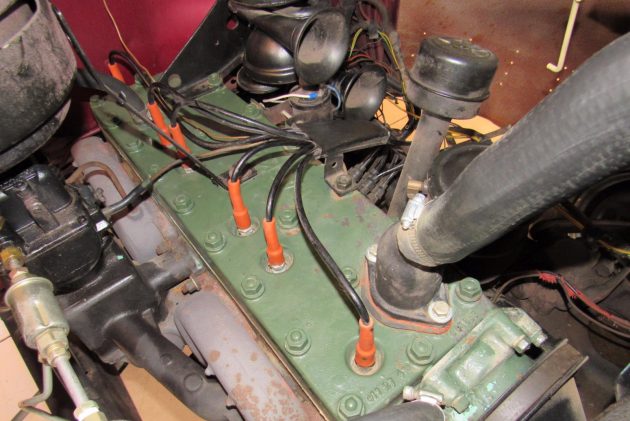World War II largely curtailed American automobile production as automakers focused on producing machines of war. Few passenger cars were built during the war years, and new designs were largely put on hold. This probably explains why this 1942 Packard was built in 1943. Provenance includes its delivery to Beverly Hills Packard. After that, this car may or may not have been sold to the late President and movie star Ronald Reagan. Whether true or not, the story adds interest, and a car with an interesting but unverified story beats one with no story any day. Regardless it currently resides in Cave Creek, Arizona and awaits a new owner here on eBay.
That looks like bare metal, and most pre-war cars would not look this good when stripped bare. The shiny bits look great too – possibly re-chromed. Reagan starred with Errol Flynn in 1942’s Oscar-nominated war movie Desperate Journey, and would have likely had no trouble dropping $1,500 for a 6-cylinder Packard convertible that year, which totaled slightly less than a year’s wages for the average family. Though the listing includes few details about the car’s current status, it appears caught in mid-restoration, perhaps hastily reassembled for sale. If you haven’t seen one of these Packards up close, you might think they look like other coupes and convertibles of their day, but few cars can match a Packard’s stateliness and presence in person.
Not much to complain about inside, except the hole in the dashboard. Packards were well-appointed and upscale, and this Clipper Six is no exception. While listed as a “110,” that designation for six-cylinder Packards ended in 1941, after which they were named Clipper Six (and the 8-cylinder models Clipper Eight). Meanwhile Packard built amazing airplane and marine engines for the war effort. Some details from Hemmings.
A movie star like Ronald Reagan, flush with cash, might have sprung for Packard’s velvety straight-8 cylinder, but the war may have limited the buyer’s choices to the smooth but less powerful I6. Packard’s motto “Ask the man who owns one,” somewhat implies that their excellence was a secret. By 1942, the luster of the era when Packard stood as tall as Cadillac or any American luxury car were history, and the company’s hopes that the Clipper, freshly designed for 1941, would revive the company, were largely dashed by the war. When Clipper production resumed in 1946, the design had lost its edge. Nearly any Packard will appreciate over time if bought well. We don’t know much about this specimen beyond what we can see, and the seller says it runs and moves but has no brakes. What do you think of this one?






If this car were built in 1943 it may have used parts that were left over when production ended March 1942. I cannot see a way that Packard would have gotten permission from the WPA to use new raw material for such a car. I do like the dark red and cream color combo. It would really pop if completed.
Good stuff Todd, but the Standard Catalog of American Cars does not list a Clipper as a model in 1942. 1941 was the final year for that series. Packard played, shall we say, a few games with names and Series and the cars looked the same.
The hole in the dash could be where the jellybean dispenser was located. If the original headliner is in place there should be a star chart painted on it clearly showing the signs of the zodiac which would confirm it was indeed owned by Regan.
First off, weren’t the six cylinder Packards considered the Junior Packards?
You have to wonder why the car is half restored . Given it’s surroundings it appears the seller could finish it. Seems like it would be more valuable finished.
As for the connection to Raygun , whether that makes it’s more valuable I’ll leave to the idealogues. Needless to say showing a request to DMV to verify ownership doesnt amount to a hill of beans. Now if they had replied with a copy of Raygun’s registration, you might have something.. But sales is sizzle I guess.
The value of any vehicle with Presidential provenance is certainly enhanced, even President Golf Cart’s Escape Hybrid. That said, you are entirely correct that such provenance must be proven and a DMV query is worthless by itself.
As to this particular Packard, it is doubtful that Ronaldus Magnus owned it. At the time this car was delivered new Reagan was a 2LT liason officer in Calif. Yes, his film career was off to a good start at this point but he certainly hadn’t achieved any kind of ‘superstardom’ yet. New vehicles were being tightly rationed at this time and it’s extremely doubtful that Reagan had enough clout at this point in his career to make the list. If Reagan once owned this car, it’s highly improbable he bought it new.
Still, Reagan’s affection for Packards is well known, so it’s possible. Reagan owned a LOT of vehicles during his time, but I can find no connection between him and this car – or any 1942 Packard.
No sale.
That data plate looks weird.
I would bet that the data plate has been removed, changed and replaced. The affixing rivets look too new. Or, its from another like car entirely.
Looking at other data plates online, it seems that Packard typically used only numbers for the date. They would have stamped something like “1-5-43”. Also the letters look like they were individually stamped – far too messy for the factory process that would have used a jig. Then there’s the obvious – according to the Automobile Manufacturers Assoc. the total cars from ALL manufacturers were (1943) 139 made and (1944) 610 made. They were dedicated for military use, and likely not a sporty model, and probably not a Packard.
Packard Serial number plates* were mounted to the firewall with 4 small screws and can be removed with a screwdriver. The top line should be a 4 digit number describing the series and body style, then a dash, then the actual sequential number. This appears to have the motor serial number stamped in the top line.
It’s also a reproduction plate. The 2 Packards I’ve seen from Beverly Hills Packard were not stamped into the metal, they used an inked stamp, this was done for warranty purposes and convenience, so they didn’t have to remove the plate.
It’s not a 1943 Packard, they didn’t make any. However if the car was sold in 1943, it might have been registered as a 1943. But it’s a ’42.
As for the Claim it’s a Clipper, It’s not. But they did build Clipper models in 1941 & 42. In 1941, Clippers were only offered in the 120 [eight] series. in 1942 they were available in the Six, Eight, Super Eight and Custom Super Eight series cars [110, 120, 160 and 180 models].
Clippers were ONLY 4-door sedans in 1941, and a 2-door fastback was introduced in 1942 see photo]. Only one Clipper convertible was built, said to have been done for the actor Errol Flynn.The same cars with only slight trim changes like the center grill, became the 1946/47 Packards.
*In 1938 Packard made a major mistake: Instead of a serial number plate, they used a DECAL with the serial number printed on the decal.The decals simply disintegrated due to age and heat, and you won’t find an original one today. Many ’38s had factory serial number metal plates added by the Packard dealer, when the decal failed. Blank plates could be ordered from the factory — It was a different time. Imagine trying to order a blank VIN plate today!
Thanks Bill, I enjoy your Packard expertise. I miss my Packard every time one gets featured.
Reagan was a Cadillac Man.
or…. a Green Acres Hill Billy.
I have a soft spot for vintage Packards. They had style , graceful lines and character that not many others had from that time . Many innovations that were ahead of their time.
There is a Packard Museum in Dayton , Ohio on Ludlow Street that has many fine examples and is housed in an old Packard Dealership. Building. You can also see a Packard Marine Engine as used in PT Boats and also aircraft engines…
They even have a Packard Truck.
I have a Packard truck…..they stoped building them in 1923.
I was going to write something a touch profane
about Jane Wyman, but thought better of it.
Wow – great comments here. I love Packards, especially the pre-crash models, but would love to put this in my garage. I have been poking around on the web and wanted to explain how I came to the conclusion that this was a “Clipper Six” and not a 110, even if my sources were wrong. I found at least two sites while researching the piece that said they started calling the 100 a “Clipper Six” in ’42 and two below that refer to it as a “Packard Six.” I also knew the Clipper was a separate model that started in 1941. I’m not an expert and it seems there is some confusion out there. Maybe one person started down the wrong trail then others simply copied and pasted the error. I love hearing the personal comments though, and I learn something every day from you all.
“For 1942, Packard made a decision to retain numerical designated models within its senior line and the One-Ten reverted to being called Packard Six.” https://en.wikipedia.org/wiki/Packard_One-Ten and “For 1942, Packard’s One-Ten model was renamed to the Six” http://www.conceptcarz.com/vehicle/z8079/Packard-Special-Clipper-110.aspx
Ask Bill McCoskey…….he is the real deal expert.
The mere fact it was reagan’s car – it should be sent directly to the crusher
and melted…
Appears to have sold for $20,044